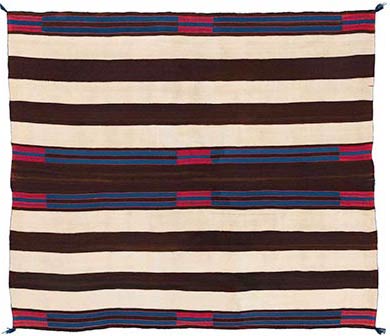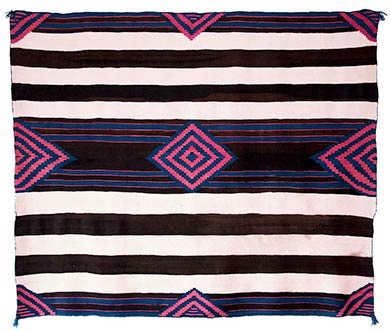Upper Left: A Classic First Phase Chief’s Blanket, Ute Style, Navajo, circa 1830
Upper Right: A Classic Bayeta Second Phase Chief’s Blanket, Navajo, circa 1850
Lower Left: A Classic Bayeta Third Phase Chief’s Blanket, Navajo, circa 1850
Lower Right: A Classic Chief’s Blanket Variant, Ute Style, Navajo, circa 1840
What’s the Difference Between a First Phase, a Second Phase, a Third Phase, and a Variant?
In Navajo culture, weaving a copy of a blanket you had already woven was taboo.The taboo led to innovation. Innovation became a hallmark of classic Navajo weaving.
Between 1800 and 1830, Navajo chief’s blankets were simple arrangements of brown, blue, and white bands. Between 1830 and 1860, Navajo weavers added design elements to the bands.Thin red stripes were an early innovation, followed by horizontal rectangles, concentric squares, and terraced diamonds.
As the chief’s blanket evolved, Anglo-Americans categorized chief’s blankets according to their designs. Chief’s blankets with horizontal bands and stripes, but no designs, came to be known as “first phases.” Chief’s blankets with concentric squares or horizontal rectangles were called “second phases.” Chief’s blankets with terraced diamonds were called “third phases.” Chief’s blankets with combinations of horizontal rectangles, concentric squares, terraced diamonds, or other geometric designs were called “variants.”
While there are no words in Navajo for “first phase,” “second phase,” “third phase,” or “variant,” repeated use of these terms by Anglo-American traders made them part of the vocabulary now used by auction companies, collectors, dealers, and scholars when we talk about Navajo chief’s blankets.
Learn more about Classic Navajo Chief's Blankets.






